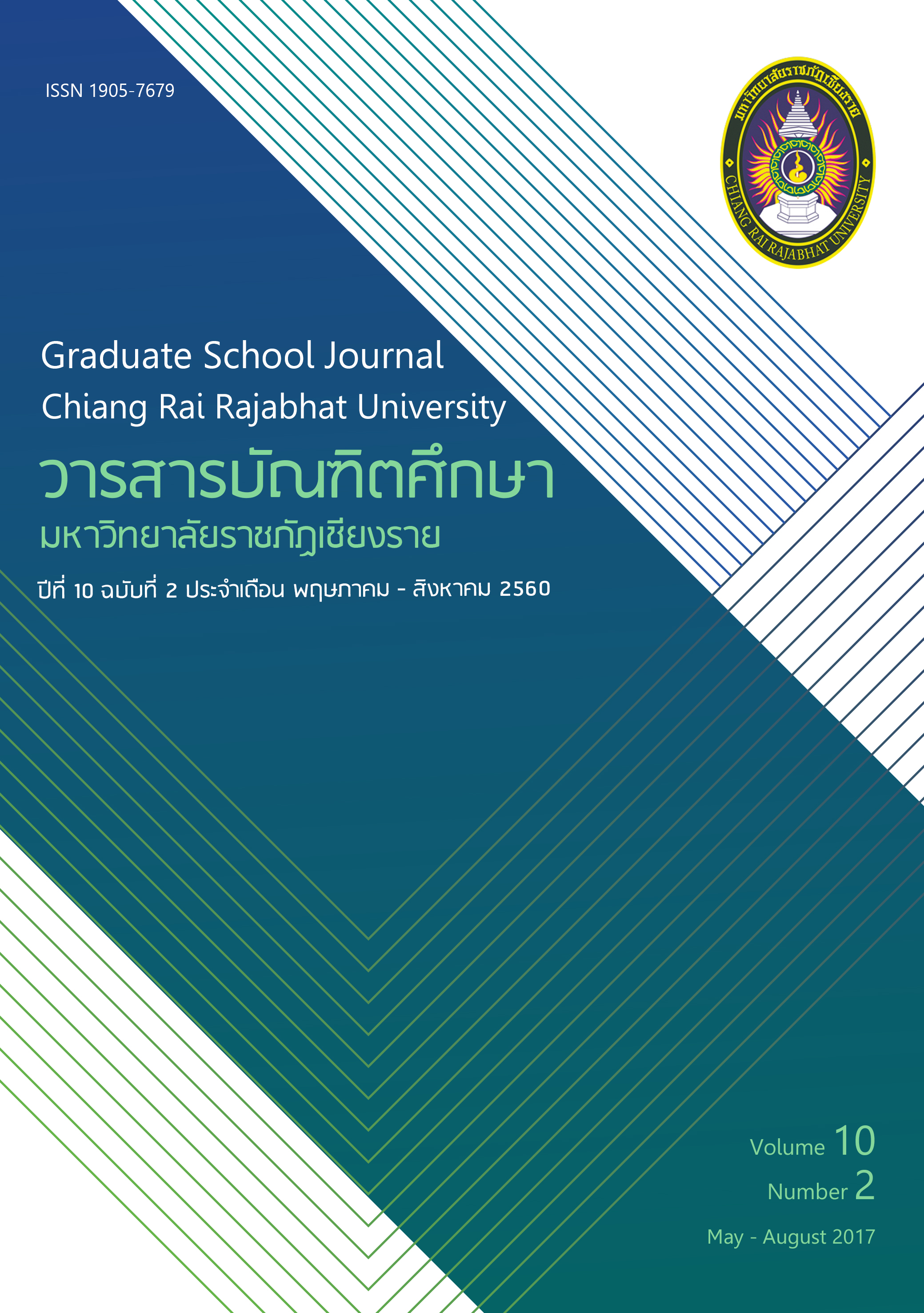A Development of Instructional Model with Augmented Reality Technology for Graduate Students
Main Article Content
Abstract
This research aimed to develop the instructional model with augmented reality
technology for graduate students. There were two steps of the research being conducted:
1) the step of developing instructional model with augmented reality technology for
graduate students and 2) the step of doing try out the instructional model with augmented
reality technology for graduate students. The sampling consisted of 22 graduate students
of Curriculum and Instruction Program, Nakhonsawan Rajabhat University, selected by
purposive sampling from students who attended Information Technology and Innovation
for Learning subject in the second semester of the academic year 2016. Two research
instruments were instructional model with augmented reality technology and achievement
test. Data analyzed by using mean, standard deviation and dependent sample t-test.
The result of this research were as follow:
1. The instructional model with augmented reality technology for graduate students
consisted of three systematic components: 1) Input: to prepare and specify role of
teacher and students 2) Process: to learn with augmented reality technology using by
9 teaching steps of Gagné and 3) Output: to evaluate learning achievement.
2. The quality of instructional model with augmented reality technology for
graduate students was at the highest level ( = 4.88, S.D. = 0.21)
3. The posttest score of graduate students learning with instructional model with
augmented reality technology was higher than the pretest score at the .05 level of
signifcance.
Article Details
บทความที่ได้รับการตีพิมพ์เป็นลิขสิทธิ์ของวารสารมหาวิทยาลัยราชภัฎเชียงราย
ข้อความที่ปรากฏในบทความแต่ละเรื่องในวารสารวิชาการเล่มนี้เป็นความคิดเห็นส่วนตัวของผู้เขียนแต่ละท่านไม่เกี่ยวข้องกับมหาวิทยาลัยราชภัฎเชียงราย และคณาจารย์ท่านอื่นๆในมหาวิทยาลัยฯ แต่อย่างใด ความรับผิดชอบองค์ประกอบทั้งหมดของบทความแต่ละเรื่องเป็นของผู้เขียนแต่ละท่าน หากมีความผิดพลาดใดๆ ผู้เขียนแต่ละท่านจะรับผิดชอบบทความของตนเองแต่ผู้เดียว
References
ความเป็นจริงเสริมเพื่อพัฒนาทักษะการสร้างสรรค์และนวัตกรรมสำหรับนักศึกษา
ระดับปริญญาตรี. (วิทยานิพนธ์วิทยาศาสตรมหาบัณฑิต). มหาวิทยาลัยเทคโนโลยีพระจอมเกล้า
พระนครเหนือ. กรุงเทพฯ.
ใจทิพย์ ณ สงขลา. (2550). E-instructional design วิธีวิทยาการออกแบบการเรียนการสอน
อิเล็กทรอนิกส์. กรุงเทพฯ: โรงพิมพ์แห่งจุฬาลงกรณ์มหาวิทยาลัย.
ทรงพล ขันชัย. (2554). การพัฒนาแบบจำลองเพื่อการศึกษาโดยใช้เทคโนโลยีความจริงเสริม
กรณีศึกษาแบบหลายมาร์คเกอร์. (วิทยานิพนธ์วิทยาศาสตรมหาบัณฑิต). มหาวิทยาลัยเชียงใหม่.
เชียงใหม่.
ทิศนา แขมมณี. (2550). ศาสตร์การสอน. (พิมพ์ครั้งที่ 5). กรุงเทพฯ: โรงพิมพ์แห่งจุฬาลงกรณ์
มหาวิทยาลัย.
วัชรพงษ์ โถรัตน์ และคนอื่นๆ. (2560). จิ๊กซอว์ : ตารางธาตุแบบความเป็นจริงเสริมสำหรับการสนับสนุน
การเรียนรู้แบบร่วมมือ. ใน การประชุมวิชาการระดับชาติด้านคอมพิวเตอร์และเทคโนโลยี
สารสนเทศ ครั้งที่ 13 = The 13th national conference on computing and information
technology (NCCIT 2017) (หน้า 75). กรุงเทพฯ: มหาวิทยาลัยเทคโนโลยีพระจอมเกล้า
พระนครเหนือ และมหาวิทยาลัยเครือข่าย.
สถาบันส่งเสริมการสอนวิทยาศาสตร์และเทคโนโลยี. สื่อเสริมการเรียนรู้ออกเมนเต็ด เรียลลิตี้. สืบค้นเมื่อ
20 กรกฎาคม 2560, จาก http://secondsci.ipst.ac.th
Azuma, R. T. (1995). The most important challenge facing augmented reality.
In ACM SIGGRAPH 1995 (Los Angeles, 6-11 August 1995) (pp. 20-38).
25(3), 234-238.
Azuma, R.T., Yohan, B., Behringer, R., et al. (2001). Recent advances in augmented reality.
IEEE, 25(3), 95.
Fosnot, C. (2005). Constructivism : Theory, perspectives, and practice. New York:
Teachers College Press.
Gagne´, R. M., Briggs, L. J, and Wager, W. W. (1992). Principles of instructional design.
(4th ed). New York: Harcourt Brace College Publisher.
Huitt, W. (2011). Bloom et al.’s taxonomy of the cognitive domain. Educational
Psychology Interactive. Retrieved from http://www.edpsycinteractive.org/topics/
cognition/bloom.html
Johnson, L., Smith, R., Willis, H. et al. (2011). The 2011 horizon report. Austin,
TX: New Media Consortium.
Kipper, G., and Rampolla, J. (2013). Augmented reality : An emerging technologies
guide to AR. Waltham, MA: Syngress.
Rodgers, C. (2014). Augmented reality book and the reading motivation of
fourth-grade students. (Doctor of Education in Educational Leadership). Union
University School of Education. n.p. New York: Plenum Press.

